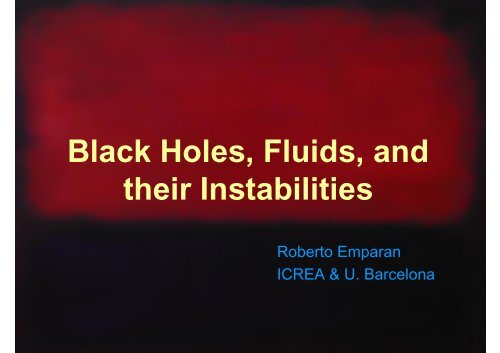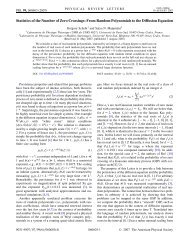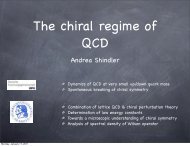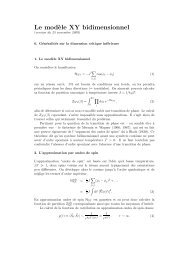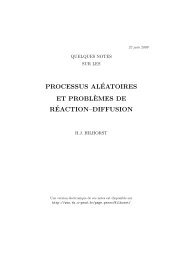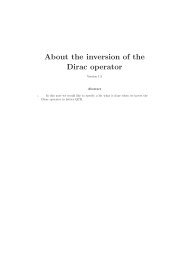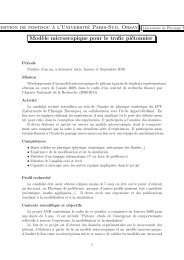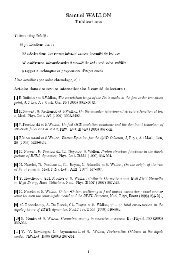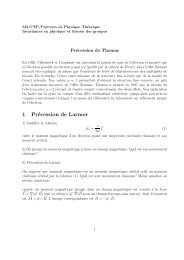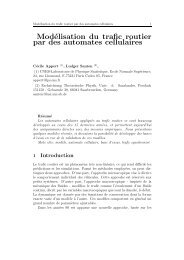Roberto Emparan
Roberto Emparan
Roberto Emparan
Create successful ePaper yourself
Turn your PDF publications into a flip-book with our unique Google optimized e-Paper software.
Black Holes, Fluids, and<br />
their Instabilities<br />
<strong>Roberto</strong> <strong>Emparan</strong><br />
ICREA & U. Barcelona
“Black Holes are like Fluids”
“Black Holes are like Fluids”<br />
What does this mean<br />
What is it good for
“Black Holes are like Fluids”<br />
What does this mean<br />
• Some of the dynamics of a black hole<br />
spacetime takes the form of the equations<br />
for some kind of fluid system
“Black Holes are like Fluids”<br />
What does this mean<br />
• Some of the dynamics of a black hole<br />
spacetime takes the form of the equations<br />
for some kind of fluid system<br />
– What part of the dynamics<br />
• All of the spacetime Only the region near/inside<br />
the horizon Only long wavelength fluctuations<br />
– What kind of fluid<br />
• Relativistic/Non-relativistic<br />
• Incompressible/Barotropic/Conformal...<br />
• With/without a surface boundary
“Black Holes are like Fluids”<br />
What is it good for<br />
• Einstein eqs: Coupled non-linear PDEs<br />
• Navier-Stokes: Coupled non-linear PDEs
“Black Holes are like Fluids”<br />
What is it good for<br />
• Einstein eqs: Coupled non-linear PDEs<br />
• Navier-Stokes: Coupled non-linear PDEs<br />
• But typically, in the mapping the fluid lives<br />
in fewer dimensions than the bh –<br />
“holographic reduction”<br />
• Lots of theoretical/numerical/exptl work on<br />
fluids<br />
• Universal results for black holes
“Black Holes are like Fluids”<br />
What is it good for<br />
This talk:<br />
• BH perturbations and stability analyses<br />
are very complicated<br />
• Fluid description may simplify the system<br />
• Case study: Gregory-Laflamme-type<br />
instabilities
Gregory-Laflamme instability<br />
λ=2π/k t r 0<br />
r 0<br />
Ω(k) δr 0 ∼ e Ωt+ikz<br />
Linearized perturbation analysis<br />
(D=n+4)<br />
(plot data: Figueras)
Fluid dynamics<br />
• Effective theory for fluctuations away from<br />
thermodynamic equilibrium, whose<br />
frequency ω → 0 as wavelength λ → ∞<br />
• Long-wavelength expansion, relative to<br />
– molecular mean free path: theory comes with<br />
a scale<br />
– thermal wavelength: scale set by state<br />
• Fluid eqs: ∇ µ T µν =0<br />
(T µν from constitutive relations)
General Relativity as Fluid dyn<br />
• Classical vacuum theory (R µν =0) is scaleinvariant<br />
• Black holes set a length scale r H ~GM<br />
• It’d seem (naively) that a fluid description<br />
should capture only fluctuations with<br />
λ p r H : can’t fit!<br />
• Instead, theory may have a scale, eg, a<br />
cosmo constant. Then fluid may capture<br />
λ p L cosmo
Membrane paradigm<br />
Damour<br />
Thorne et al<br />
Bredberg et al<br />
• An outside observer interacting with a<br />
black hole (perturbing it) can replace it<br />
with a membrane endowed with sources of<br />
stress-energy (viscous fluid), charge<br />
(resistive) current etc<br />
• Fluid lives on<br />
(stretched) horizon
Membrane paradigm<br />
• Fluid stress-tensor: quasilocal Brown-York<br />
8πGT µν =K h µν −K µν<br />
• Captures dynamics of horizon (+inside),<br />
and its coupling with outside -- not full<br />
spacetime
Membrane paradigm<br />
• Fluid dyn obtains (exactly!) because of<br />
huge redshift near horizon:<br />
– acceleration-length a -1 → 0<br />
– local temperature for fidos → ∞<br />
• Near-horizon is Rindler: universal, erases<br />
differences among distinct black holes (eg<br />
black holes vs black branes): good/bad<br />
• Not good for studying bh instabilities
BHs as fluid droplets/lumps<br />
• Analogy:<br />
≃<br />
• Fluid drop with surface boundary tends to<br />
extremize (minimize) surface area<br />
• Surface is elastic<br />
• Fluid drops evaporate when microphysics<br />
included, evaporation rate greater for<br />
smaller drops
BHs as fluid droplets/lumps<br />
• Rayleigh-Plateau / Gregory-Laflamme<br />
Cardoso+Dias
BHs as fluid droplets/lumps<br />
• Rayleigh-Plateau vs Gregory-Laflamme<br />
Cardoso+Dias
BHs as fluid droplets/lumps<br />
• Highly suggestive! But...
BHs as fluid droplets/lumps<br />
• Highly suggestive! But...<br />
• Problematic for vacuum black holes/branes<br />
• Fluid drops have an intrinsic scale: can tell<br />
large and small drops<br />
• Vacuum bhs (eg Schw) don’t have any<br />
intrinsic scale: all equal<br />
• We’re trying to relate systems with different<br />
numbers of parameters!
BHs as fluid droplets/lumps<br />
Possible fixes:<br />
Caldarelli+Dias+RE+Klemm<br />
Miyamoto+Maeda<br />
• Consider not vacuum bhs, but bhs in AdS<br />
– Can tell large and small bhs<br />
– Large black holes can fit long-wavelength<br />
fluctuations<br />
• Small parameter 1/N (number of<br />
dimensions): large N expansion<br />
– large-N bhs are large
BHs as fluid drops/lumps<br />
• Large BHs in AdS: fluid lumps<br />
• BHs in gravitational duals to confining<br />
theories: AdS with “infrared bottom”<br />
• BH is dual to plasma ball: with surface<br />
boundary<br />
Aharony+Minwalla+Wiseman<br />
• “Analogy” upgraded to precise “duality”<br />
– although, actually, no independent<br />
construction of gravitational side<br />
– fluid “prediction” for GL instab of black branes
Fluid/gravity correspondence(s)<br />
Bhattacharya et al<br />
• A spin-off of AdS/CFT, but conceptually<br />
independent of it<br />
• Long-wavelength fluctuations of AdS black<br />
brane captured by effective fluid at<br />
asymptotic timelike boundary<br />
• Relativistic conformal fluid
Fluid/gravity correspondence(s)<br />
• Stress-tensor is again quasilocal Brown-<br />
York<br />
8πGT µν =K h µν −K µν<br />
• Full spacetime reconstructed from fluid<br />
dyn solution+horizon regularity<br />
• Fluid not exact:<br />
derivative expansion<br />
• Conformal fluid is stable
Fluid/gravity correspondence(s)<br />
Blackfold approach:<br />
• long-wavelength dynamics of black holes,<br />
incl. vacuum, charged etc<br />
• black hole is locally like<br />
a black brane<br />
RE+Harmark+Niarchos+Obers<br />
• Extrinsic dynamics: elastic<br />
• Intrinsic dynamics: fluid
General Classical Brane Dynamics<br />
• Dynamics of a fluid on a dynamical<br />
worldvolume<br />
• Fluid-dynamics: long-wavelength deviations from<br />
thermodynamic equililbrium<br />
• Generalized geodesic eqn (Carter): elastic deformations<br />
at long wavelengths
Blackfold fluid<br />
• Effective stress tensor T µν<br />
– Quasilocal Brown-York, measured in AF region of<br />
planar black brane<br />
• Leading-order ‘black brane effective fluid’:<br />
T µν =(ε+P)u µ u ν +Ph µν<br />
ε = (n+1)r 0<br />
n<br />
P = −r 0<br />
n<br />
n =D−p−3<br />
• (viscosity at next order also computed)
Blackfold effective theory<br />
∇ µ T µν =0 Blackfold equations<br />
for: u µ (wv boost), r 0 (thickness), Κ ρ (X µ ) (embedding)<br />
Coupled elastic and fluid dynamics:<br />
˙u µ + 1<br />
n + 1 uµ ∇ ν u ν = 1 n Kµ + ∇ µ ln r 0<br />
acceleration & expansion external (curvature) force & pressure gradient
Blackfold effective theory<br />
• Can be used for finding new stationary<br />
black holes<br />
• Also for studying their dynamics at longwavelengths<br />
– much simpler stability analysis<br />
– can go beyond linear perturbations<br />
• Simplest instability: Gregory-Laflammetype
Gregory-Laflamme as sound-mode<br />
instability<br />
δr 0 ∼ e Ωt+ikz<br />
Ω(k)<br />
threshold<br />
zero-mode k=k GL<br />
Ωr 0<br />
k r 0<br />
Hydrodynamic regime<br />
Ω ≃ 0, k ≃ 0<br />
λ ≫ r 0<br />
λGL ≃r 0
Gregory-Laflamme as sound-mode<br />
instability<br />
• Sound waves of “black string fluid”:<br />
δP → δr 0<br />
ε=−(n+1) P<br />
P = −r 0<br />
n<br />
r 0<br />
λ ≫ r 0<br />
• Sound velocity c s2 = dP/dε < 0 : Unstable<br />
Ω = √ −c 2 s k + O(k 2 ) =<br />
k<br />
√ n + 1<br />
+ O(k 2 )<br />
Ω<br />
Almost effortless!<br />
RE+Harmark+Niarchos+Obers<br />
k
Viscous damping of sound<br />
• Viscosity allows to compute next order<br />
Ω =<br />
(<br />
k<br />
√ 1 − n + 2 )<br />
n + 1 n √ n + 1 kr 0<br />
Viscous 1+1 fluid<br />
(Camps+RE+Haddad)<br />
Numerical Gregory-Laflamme<br />
(P.Figueras)
Viscous damping of sound<br />
• Agreement is impressively good for large n<br />
Ω =<br />
(<br />
k<br />
√ 1 − n + 2 )<br />
n + 1 n √ n + 1 kr 0<br />
(discrepancy c 1/n)<br />
T =<br />
n<br />
4πr 0<br />
“Large-n limit of black holes = fluid dynamics”
Gregory-Laflamme as sound-mode<br />
instability<br />
• This is not:<br />
– Rayleigh-Plateau instability of fluid tubes<br />
(no surface boundary)<br />
– Jeans instability of gravitating fluid<br />
(no gravity acting on fluid)<br />
• It is:<br />
– Sound-mode instability<br />
– Thermodynamic instability: c s2 =s/C v
Gregory-Laflamme from fluid dynamics<br />
• Huge simplification from full Einstein<br />
equations:<br />
– radial dependence holographically solved<br />
– linearized analysis becomes algebraic<br />
– non-linear analysis is 1+1 instead of 2+1<br />
• Easily extended to other branes:<br />
– leading-order instab only requires eq of state:<br />
no perturbations<br />
– can do charged, rotating... branes
Gregory-Laflamme from fluid dynamics<br />
• Simple, explicit proof of Gubser-Mitra,<br />
applicable to generic black branes<br />
• G-M applies only to perturbations that<br />
have a hydrodynamic limit: infinitely<br />
extended branes
Gregory-Laflamme from fluid dynamics<br />
• Applies to blackfold (brane-like) regime of<br />
hi-d black holes<br />
• Includes black holes with compact<br />
horizons: MP bhs, black rings etc
Gregory-Laflamme from fluid dynamics<br />
• Can we follow non-linear evolution<br />
– Hard-core numerics of Lehner+Pretorius cry<br />
out for fluid interpretation/simplification<br />
black string<br />
fluid column<br />
Lehner+Pretorius<br />
Brenner et al
Gregory-Laflamme from fluid dynamics<br />
• Can we follow non-linear evolution<br />
– Hard-core numerics of Lehner+Pretorius cry<br />
out for fluid interpretation/simplification<br />
– Not only simplify/reinterpret L+P for vacuum<br />
black strings: extend to other black branes<br />
with qualitatively different properties<br />
• Capitalize on theory of drop formation
Gregory-Laflamme from fluid dynamics<br />
Capitalize on theory of drop formation<br />
Camps+RE+Haddad+Miyamoto<br />
• Self-similar critical attractor near pinch-down<br />
• Captured exactly by effective 1+1 theory (like<br />
blackfold description of black string)<br />
Eggers<br />
self-similar evolution of pinch-down
End-point of instability: A proposal<br />
• Fluid tube breaks when thin-neck dynamics<br />
dominated by evaporation<br />
• Black string will break by quantum evaporation<br />
effects: breaking controlled by same physics as<br />
in endpoint of bh evaporation<br />
• In (weakly coupled) string theory, this happens<br />
at “correspondence point” (before Planck scale)<br />
evaporating string-ball
Conclusions<br />
• Several meanings to “black holes are like<br />
fluids”<br />
• Fluid/gravity correspondences: fluid from<br />
quasilocal stress tensor at timelike<br />
boundary, long wavelengths, seems to<br />
encompass (almost) all versions<br />
• BHs as fluid lumps: dual “plasma balls”, bh<br />
in AdS w/ IR bottom
Conclusions<br />
• Fluid/AdS gravity and blackfolds put fluid<br />
at asymptotic boundary<br />
• Membrane paradigm puts it at horizon<br />
• Holographic RG flow interpolates between<br />
them<br />
• Fluid/gravity correspondences: very<br />
efficient way to study horizon instabilities<br />
when bh has brane-like regime


